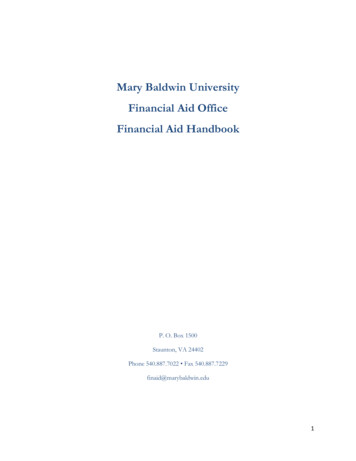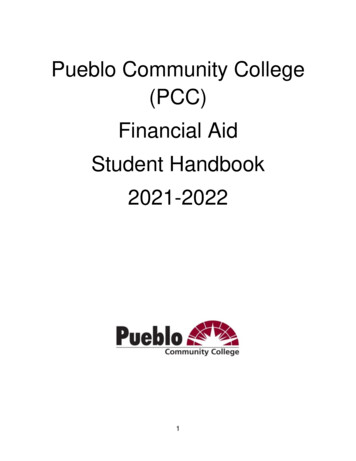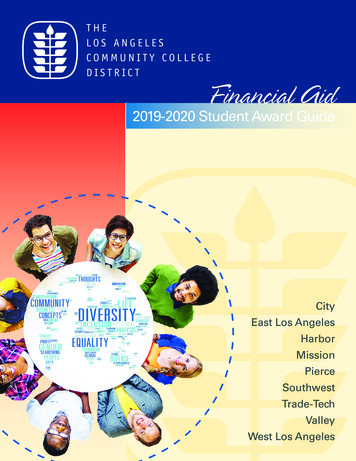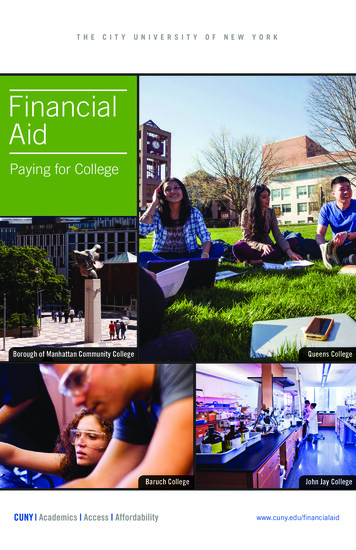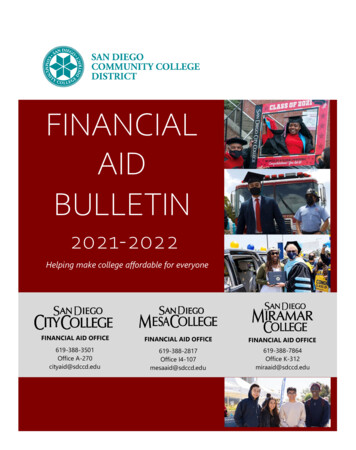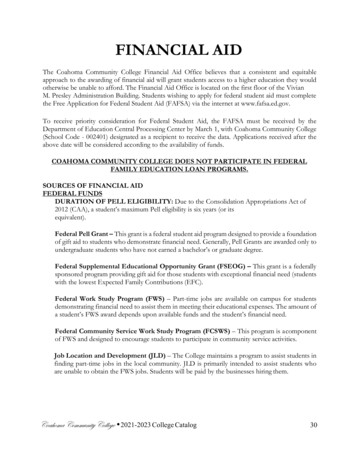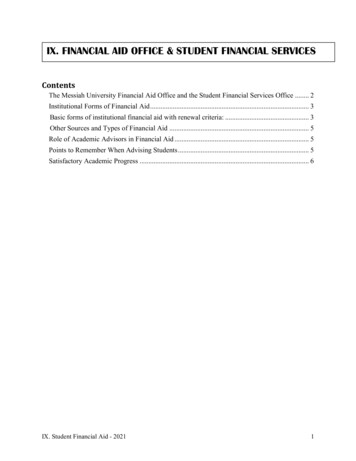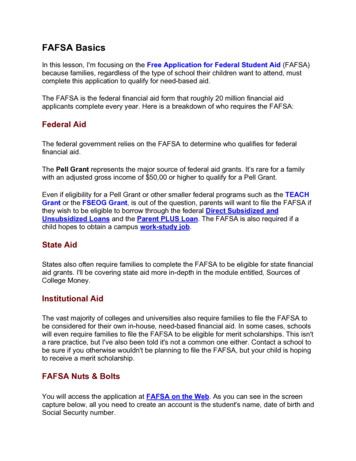
Transcription
FAFSA BasicsIn this lesson, I'm focusing on the Free Application for Federal Student Aid (FAFSA)because families, regardless of the type of school their children want to attend, mustcomplete this application to qualify for need-based aid.The FAFSA is the federal financial aid form that roughly 20 million financial aidapplicants complete every year. Here is a breakdown of who requires the FAFSA:Federal AidThe federal government relies on the FAFSA to determine who qualifies for federalfinancial aid.The Pell Grant represents the major source of federal aid grants. It’s rare for a familywith an adjusted gross income of 50,00 or higher to qualify for a Pell Grant.Even if eligibility for a Pell Grant or other smaller federal programs such as the TEACHGrant or the FSEOG Grant, is out of the question, parents will want to file the FAFSA ifthey wish to be eligible to borrow through the federal Direct Subsidized andUnsubsidized Loans and the Parent PLUS Loan. The FAFSA is also required if achild hopes to obtain a campus work-study job.State AidStates also often require families to complete the FAFSA to be eligible for state financialaid grants. I'll be covering state aid more in-depth in the module entitled, Sources ofCollege Money.Institutional AidThe vast majority of colleges and universities also require families to file the FAFSA tobe considered for their own in-house, need-based financial aid. In some cases, schoolswill even require families to file the FAFSA to be eligible for merit scholarships. This isn'ta rare practice, but I've also been told it's not a common one either. Contact a school tobe sure if you otherwise wouldn't be planning to file the FAFSA, but your child is hopingto receive a merit scholarship.FAFSA Nuts & BoltsYou will access the application at FAFSA on the Web. As you can see in the screencapture below, all you need to create an account is the student's name, date of birth andSocial Security number.
Before submitting the FAFSA, a parent and the student must each obtain a FAFSAPIN. These PIN numbers are required to electronically sign the FAFSA form online andretrieve the family’s financial aid records.When To File the FAFSAThe federal government releases the latest FAFSA on January 1 each year. It's best tocomplete the FAFSA as soon as possible because colleges have financial-aid deadlinesand so do states. Some states, such as Illinois, Kentucky, North Carolina, Vermont andWashington, dispense money to eligible students on a first-come, first-serve basis untilthe money runs out.You can find out what the deadlines are for many states by looking on the front page ofthe federal government's FAFSA on the Web Worksheet 2015-2016. The worksheetcontains some of the FAFSA questions so it's smart to check it out before tackling thereal application. Here is a snapshot of the worksheet’s front page that always containsthe state deadlines on the front page:
The aid deadline that you don't have to worry about missing is the federal government's.The FAFSA filing period is always 18 months and for the coming 2015-2016 schoolyear, it will range from Jan. 1, 2015 to June 30, 2016.To complete the FAFSA, you will need your latest income tax return, as well as nonretirement investment accounts and bank statements. If you are up against an early aiddeadline, you can file the FAFSA using estimated income tax figures. Once your taxesare completed, you will have to update the FAFSA.If you have a lower adjusted gross income – below 50,000 — you may qualify forsomething called the Simplified Needs Test, which doesn’t require that you discloseassets on the FAFSA. To be eligible for the Simplified Needs Test, you must be able tofile a 1040A or 1040EZ tax form.The ability to avoid revealing assets can be a lifesaver for a family with little income(perhaps due to unemployment), but which possesses significant wealth. It can also behelpful for a divorced parent who has assets from a divorce settlement, but who doesnot have a good-paying job. You'll learn more about divorce in the lessonentitled, Divorce, Separation and Financial Aid.IRS Retrieval ToolFamilies completing the FAFSA can speed up the process by using the IRS DataRetrieval Tool. When you reach questions concerning tax information, you will beasked if you have already completed your federal tax return and then you'll be screenedfor your eligibility to use the tool. If eligible, you'll be transferred to the IRS website toconfirm the data transfer and then returned to the FAFSA.You can use the tool approximately two weeks after filing your taxes electronically. Thetool does not become available until early February. You can also use the tool to updatea FAFSA application, which you had completed with estimated taxes.
Besides speeding up the FAFSA process, any data transferred from the IRS unmodifiedwon't be subject to verification.You can't use the tool if: If you are married and filing separately.If you filed an amended return.If you filed a foreign tax return.If your home address on the FAFSA doesn't match the tax return address.Pay Attention to School Order on FAFSAWhen completing the FAFSA, families need to be careful how they list the colleges thattheir child will be applying to because colleges can use that information against them.Some schools — no one knows how many – are checking the FAFSA to see in whatorder an applicant lists his or her schools. A family can designate up to 10 schools atone time on the FAFSA. The U.S. Department of Education shares the FAFSAinformation with all the designated schools on an applicant’s list, as well as applicablestate agencies that award aid.The federal government never intended for this information to be used as a tip sheet forcolleges, but it’s apparently become one.The issue came to the forefront in the fall of 2013 when Inside Higher Ed published thefollowing story on the phenomenon:Using FAFSA Against StudentsThe story suggested that schools could be denying admission and reducing aid tostudents based on the order of colleges listed on the FAFSA. Some schools might denyadmission or wait list students who put their institutions close to or at the bottom of theirlists. Schools could take this step because they are interested in maximizing their yield,which is a figure that represents the number of accepted applicants who actually attendtheir institution. Schools want their yields to be as high as possible.Equally troubling, some schools could be giving less aid to students who put their No. 1choice at the top of the FAFSA list. Schools could conclude that they don’t have to offeras much money to those applicants because they are eager to attend.I had heard about this practice, but had never seen a story regarding it, which promptedme to write the following post for my college blog at CBS MoneyWatch:Be Careful What You Share on the FAFSA
One person whom I interviewed for the piece was David Hawkins, the director of publicpolicy and research at the National Association for College Admission Counseling.He started making inquiries about the practice after an Inside Higher Ed journalistcontacted him. Hawkins told me that he was “surprised how quickly” these insiders wereconfirming the use of the FAFSA lists.How You Can Fight BackI always wondered how schools used this information, which is why when I applied forfinancial aid for my son Ben in 2010, I listed his schools in alphabetical order. It just sohappened that his No. 1 school – Beloit College — was also first on the alphabetizedlist. And that’s what I would suggest that you do. Alphabetize your list.Some families wonder if they could just list one school at a time on the FAFSA to avoidother schools getting this information. You can do this and after the application isprocessed, you can eliminate that school from your FAFSA and then resubmit a secondschool via the FAFSA and keep going through this process.The U.S. Department of Education recently added this language on its website toexplain how you can keep schools from see each other on the FAFSA.In reaction to the Inside Higher Ed report, the Department of Education began exploringwhether it should stop sharing college lists with schools. I think that is a no brainer, butthe practice is still happening. An official from the U.S. Department of Education told meon background recently that the department is researching changes to the schooldisclosure issue for the 2016-2017 school year or later.Common FASFA MistakesI wish that I could reassure you that completing the FAFSA is easy, but it won't be formany parents. Even more disconcerting is that parents make mistakes all the time anddon't even realize it.Some of the mistakes in this lesson may seem obvious, but others will probably surpriseyou. Here are 12 FAFSA mistakes to avoid:1. Reporting an incorrect household size.This one might seem puzzling. After all, parents should know who lives under their roof,but it’s not that easy. Here are some reasons why:If a stepparent has children from a previous marriage those children could potentially beincluded in the household size even if they don’t live in the residence. They would
qualify as household members if the parent provides more than half of his or hersupport and will continue to do so during the financial aid award year.A parent should also include an unborn child on the FAFSA, if the baby would be bornbefore the end of the award year and will receive more than half of the support from thestudent or parent. There must be medical documentation of a current pregnancy.Parents can also include other relatives, such as grandparents, grandchildren or auntsor uncles, if they currently live in the household and will be doing so between July 1,2015 and June 30, 2016. These dates correspond with the federal financial aid seasonfor the 2015-2016 school year.Parents also wonder if they can include older children who are now in graduate schoolwhen reporting household size. You can include these grown children in the householdsize if you are providing more than half of their support. Keep in mind that student aid,including scholarships and loans, will count as student support so this is a higher hurdlethan you might assume.2. Not filing the FAFSA.Many parents assume that they won’t qualify for need-based aid so they don’t evenbother wrestling with the form. This is a huge mistake because families often have noidea whether they will qualify for financial assistance.Parents will sometimes wonder if they should not seek financial aid for their child'sfreshman year but make the request before the child’s sophomore year. The thinking isthis might help them get into the school and then seek aid once the child has a yearunder his/her belt. I once had a parent, who had saved 70,000 for a private collegeeducation, ask me about that approach.I told him that delaying the request for aid until the second year would be a poor idea.What if the child received a mediocre package that was simply stuffed with loans for hersecond year of college. Can you imagine parents having to tell a child that he/she willhave to leave for a cheaper school because they can’t afford it?A friend of mine recently provided this 2015 example of a school playing hardball with afamily when an aid deadline is overlooked:I met with a family today whose son was accepted to NYU early decision, but his fin aidapplication was late. I really don’t think the family noticed it was due, they weren’t tryingto play the game ‘get in and then ask for money’. NYU said tough luck, you missed thedeadline. He asked to be put in the regular admissions group, and they said he stillwould not be eligible for aid this year. The family is not sending him to NYU, as moneyis an issue for the family.
When parents need financial aid, they should apply for aid up front.3. Sharing the wrong marital status.It’s easy to make this mistake if a parent’s marital status has changed. The FAFSArequires that parents note what their marital status is as of the day the FAFSA is filed.So if the parents were married in 2014, but they separated in 2015, the 2015 FAFSAshould state that the parents are separated. This rule is different from what the IRSexpects. In this same example, the estranged parents would file their federal incometaxes for the 2014 calendar year as a married couple.Also, if a parent has died, only the income and assets of the surviving parent should bereported. The deceased parent's income, including Social Security income, is notincluded.4. Filing the wrong FAFSA.It’s easy to make this mistake because for much of the year, two different FAFSA formsare available online. Parents who are submitting the FAFSA for the school year thatstarts this fall should submit the 2015-2016 FAFSA. The 2014-2015 FAFSA, however,will still be available on the federal website until July 1.5. Reporting the wrong assets.The FAFSA asks about the student and parents’ investments, but you should notinclude any qualified retirement assets such as Individual Retirement Accounts,401(k)’s, 403(b)’s, KEOGH, SIMPLE, pension plans and annuities.It's also critically important to report 529 plan savings as a parent asset. If you reportthis money as the child's assets, the financial aid formulas will treat this money moreharshly.6. Reporting home equity.Parents should also not include equity in their primary home on the FAFSA. Families,however, must report the equity of other real estate. Rental property is usuallyconsidered an investment and not a business. It’s an important distinction since the aidformula treats business assets less harshly. To be considered a business, the realestate must be part of a formally recognized business. A hotel is a business whilerenting out a home, timeshare or room is generally considered an investment.7. Sharing the wrong name.
The federal government is very picky about the names that filers share on the FAFSA.Students and parents must provide the legal names that are on their Social Securitycards. A filer, for instance, shouldn’t use Jim on the form if his legal name is James. Ifthe Social Security Administration has a woman’s maiden name on file, she must usethat name until she’s updated the Social Security Administration with her married name.If the names don’t match up, the government won’t process the application.8. Not expressing an interest in a work-study job.A student who says he is interested in a work-study job on the FAFSA isn’t obligated toobtain one later, but students need to answer in the affirmative to be eligible. At someschools, most or all of the campus jobs are reserved for students eligible for work-study.9. Lying on the FAFSA.For parents who are considering lying on the FAFSA in hopes of getting financial aid,it’s not only a bad idea, it’s a crime. The federal government selects one-third of FAFSAfilings for verification each year and colleges may select additional aid applications forreview. In fact, some colleges verify 100% of their applications. Lying on the FAFSA cangenerate fines of up to 20,000 and up to five years in prison. Also the family could facerepaying all their financial aid.10. Failing to list all colleges on the FAFSA.Families are permitted to list up to 10 schools on the FAFSA. If a parent or child fails toinclude any schools, these institutions will not receive the financial information that theFAFSA generates. And that means the student wouldn’t be eligible for need-based aidfrom an overlooked school. If you are applying to more than 10 schools, the parents canadd additional names after they have received their electronic Student AidReport (SAR) from the federal government.11. Listing schools in order of preference.Keep in mind that each institution on a student's FAFSA will be able to see all the otherschools that a student is applying to. Some institutions, no one knows how many, usethe order that a student lists his or her schools to help make admission and financial aiddecisions. Your best bet is to avoid tipping your hand and simply list the collegesalphabetically.You'll learn more about a strategy to deal with this in the lesson entitled, FAFSA Basics.12. Not knowing who should file the FAFSA
Who should file the FAFSA may seem like it should be straightforward, but it often won'tbe. Here is the breakdown of the rules about who should file:Traditional Married CouplesIf you are part of a traditional family -- married husband, wife and kids - it's easy toanswer who completes the financial aid forms. Both parents will share their financialinformation on the FAFSA.Unmarried Parents Living TogetherUnmarried parents who live together have traditionally enjoyed a FAFSA perk. Only oneof the parents has had to complete the FAFSA and share his/her financial figures, butthis has changed. Both parents, who live together, are now required to complete thefinancial aid application jointly.A Parent Has DiedIf a parent dies during the year, do not include his or her financial information on theFAFSA. If the parent has died after filing the FAFSA, contact the school immediatelywith this information.Divorced and Separated ParentsIf you are divorced, the ex-spouse who has taken care of the child the majority of theyear will continue to complete the FAFSA. You are considered the custodial parent, withthe responsibility of completing the FAFSA, based on where the child has physicallylived during a 12-month period ending on the day the FAFSA is completed.Separated parents don't have to be legally separated to be treated the same asdivorced couples, but they can't be living in the same residence.You will learn more about the rules for divorced and separated parents later in thiscourse.Single-Sex CouplesThe federal government now requires that married, single-sex partners must bothinclude their financial information on the FAFSA. To reflect this change, the FAFSAasks for information for "Parent 1" and "Parent 2." In the past, only the biological parenthad to share his or her assets and income.What if the single-sex couple is not married? Both partners will have to submit financial
data if one of them has adopted the other partner's child. If a partner has not adoptedthe child, only the biological parent will complete the FAFSA.Here is a story that I wrote for my CBS MoneyWatch blog in 2013 on this rule change:Feds Push Diversity in Financial AidGuardiansIf the student is living with a legal guardian, such as a grandparent or an older sibling,the student is considered an independent student. The federal government does notconsider a guardian (or foster parent) a parent. As such, the student will only include hisor her information on the FAFSA.Any support a legal guardian or foster parent gave to the student should be reported onWorksheet B as the student's income.7 Ways to Get Help With the FASFAIt can be intimidating filling out the Free Application for Federal Student Aid (FAFSA),but here are seven resources that can help:1. Use FAFSA on the Web.The federal government can help with questions about the FAFSA, which families mustcomplete to be eligible for need-based aid and federal college loans.The FAFSA hotline number is (800) 433-3243. You can also obtain help via email.When you are working on the FAFSA online, you can also click the Live Help button forassistance.2. Download the Edvisors Network's FAFSA Guide.I recommend that you check out a valuable new guide for the 2015-2016 schoolyear, Filing the FAFSA: The Edvisors Guide to Completing the Free Applicationfor Federal Student Aid.Mark Kantrowitz, a nationally recognized financial aid expert, and David Levy, theformer financial aid director at Cal Tech, as well as Scripps and Occidental colleges,wrote this exhaustive guide, which will likely contain the answers that you are lookingfor. Filing the FAFSA is a lengthy guide that provides a line-by-line explanation of the
FAFSA, as well as advice on how to maximize financial aid, avoid errors, and completethe application painlessly.The guide is free if you download it from Edvisors.com. You can also purchasethe paperback version on Amazon or an electronic copy for a Kindle, iPad or otherdevices.Edvisors.com aims to be the go-to source for information on financial aid, justlike FinAid has traditionally been. In 2013, Kantrowitz, the creator of FinAid, becamepublisher of Edvisors, which is an umbrella organization of student loan entities, ascholarship website, and other higher-ed ventures. Last summer, Edvisors launched awebsite containing lots of financial aid articles and the site will continue to add more.3. Visit FAFSA Community - Nerd Scholar.The folks at Nerd Scholar developed the FAFSA Community to provide parents andstudents with advice on how to complete the FAFSA. The site also includes a FAFSAguide based on these four family situations: Student's parents are married.Student's parents are divorced/never married/same sex partners/one parent is dead.Student doesn't depend on one or both parents.Student has immigration issues.4. Use the FAFSA Worksheet.Completing the FAFSA will be easier if you know what documents to gather and whattype of questions to expect.That’s no problem if you use the FAFSA worksheet. The government publishes its latestversion every year at about the same time that the new FAFSA is released on Jan. 1.Here is the newest worksheet:2015-2016 FAFSA Worksheet
5. Check Out Federal Student Aid Information for Counselors.This federal site includes a great deal of information about the FAFSA for high schoolcounselors and college consultants. On the site, you can find a PDF of the FAFSA,FAFSA deadlines, FAFSA updates, a FAFSA demo and more.You will also see this resource:2015-2016 Counselors and Mentors Handbook on Federal Student Aid6. Pay a Preparer.Stories about receiving FAFSA assistance will inevitably include some variation of thisadmonition: NEVER, EVER, EVER, EVER pay anyone to complete your FAFSAor CSS/Financial Aid PROFILE.Frankly, I don’t understand why the higher-ed industry is so focused on scaring peopleaway from getting help completing these complicated documents. Why shouldn’tpeople seek out advice just as they would seek out professionals to fix theirtransmission, sell their home or file their taxes?The danger, as I see it, is that you could end up paying someone an obscene amount ofmoney for a service that should be easy for a professional.Unfortunately, some of the people who promote their services boast that they can saveyou thousands of dollars by filling out the FAFSA and PROFILE in a special way. Manyof these people are insurance salesmen who are really interested in selling youannuities and life insurance to hide your assets. You should stay away from these guys.
There is safe and inexpensive place to get help completing the FAFSA – StudentFinancial Aid Services. The cost is less than 100 and for many people I think it wouldbe worth it for the peace of mind.If you know of other low-cost resources, please let me know and I will share it.7. Take advantage of College Goal Sunday.Scattered across the country are events scheduled to help families with their FAFSA inthe weeks after January 1. College Goal Sunday events are held in dozens of statesand the District of Columbia. The California Student Aid Commission also offers helpthrough its California Cash for College workshops.CSS/ Financial Aid PROFILEThe CSS/Financial Aid PROFILE is the College Board's financial aid application thatroughly 260 private colleges and universities use, as well as some private scholarshipproviders. The following state institutions also require families to submit the PROFILE: College of New Jersey College of William and Mary Georgia Institute of Technology University of Colorado, Boulder University of Michigan, Anne Arbor University of North Carolina, Chapel Hill University of Virginia, Charlottesville Western Kentucky UniversityHere is the list of all the schools and scholarship programs that require a PROFILEsubmission:CSS/Financial Aid PROFILE schoolsPROFILE vs. FAFSAMany families wonder why they have to go through the hassle of completing thePROFILE when they've already submitted the Free Application for Federal StudentAid. It's a good question and here is the answer:All PROFILE schools use the FAFSA to determine which of their applicants will qualifyfor federal and/or state financial aid. Most public and private colleges and universitiesalso rely upon the FAFSA to determine who is eligible for the institutions' own needbased financial aid. The PROFILE schools, however, want to dig deeper than theFAFSA allows when assessing who qualifies for money from their own financial-aid
kitties. These schools insist on a more thorough assessment of the financialwherewithal of their applicants.The FAFSA, for instance, doesn't ask applicants if they own a primary home. ThePROFILE does. The FAFSA doesn't care about assets in a family business thatemploys less than 100 full-time employees. The PROFILE does. The FAFSA doesn'tinquire about assets and income from the noncustodial parent in cases of divorce andseparation, but the PROFILE schools often do.Customizing the PROFILESchools that use the PROFILE can customize this aid application in endless ways. Infact, the schools can choose from hundreds of different questions and how they treatthe answers can differ significantly. For instance, some schools consider home equity,others don't while still others link income to home equity. The latter policy is supposed tohelp families who are house rich and cash poor.What can be irritating about the PROFILE is that some of its formula is secret. TheCollege Board doesn't feel compelled to share its entire formula.The College Board, however, releases a lengthy publication every year that tries toanticipate many questions that parentswould have. I would urge you to take a look at this 54-page PDF:2015-2016 PROFILE FAQs & GlossaryDramatically Different EFCsBecause there isn't a uniform set of PROFILE questions, the Expected FamilyContribution (EFC) that this application generates for individual schools can varysignificantly for a family. A family's EFC alerts a school's financial aid office to howmuch financial assistance a student needs.Important: Because the PROFILE aid results can be so different, it's essential thatparents use net price calculators to identify whether schools may be a good financial fitor not.Consensus MethodologyTo minimize dramatically different aid results, 24 prestigious private schools, whichrequire the PROFILE, say they treat a family's information on the financial aid
application in a standardized way by using the so-called ConsensusMethodology. The schools that use the Consensus formula, including University ofChicago (pictured at right), Northwestern University, University of Notre Dame, AmherstCollege, Grinnell College, Vanderbilt University, Duke University and four Ivies, belongto the 568 Presidents Group. Presidents of these schools formed the group in the1990s when the federal government ruled that a decades-old practice of need-blindschools consulting with each other about need-based financial aid for accepted studentswas an anti-trust violation. If you're interested, you can learn more here.Under the Consensus methodology, parent and student assets aren't assessed asharshly as they are with the FAFSA and other PROFILE schools. Parent and studentassets are assessed at 5% for financial aid purposes. With other PROFILE schools,parent assets are assessed at 5%, but student assets are assessed at 25%. TheFAFSA assesses parent's assets at a maximum 5.64% and student assets at 20%.Many of the schools in this group cap home-equity calculations at 1.2 percent ofincome.You will learn more about how the PROFILE and FAFSA treat assets for financial-aidpurposes in the lesson entitled, Investments and Financial Aid.PROFILE Nuts & BoltsThe PROFILE is available much earlier than the FASFA, which is always released onJan. 1. The PROFILE release date is October 1. If your child or client will be applying forschools through Early Action or Early Decision, you will probably have to file thePROFILE weeks or even months before students who submit their college applicationsthrough the regular decision process.To file the PROFILE early, you must estimate your taxes. You can use the previousyear's tax return if your financial data will be similar, but you will have to update theapplication later. Many PROFILE schools will request a copy of your completed incometax return to check your figures.Important: Ask the schools where your child is applying when their financial aiddeadlines are because you absolutely don’t want to miss a deadline. You may forfeityour chances for financial aid if you do so. Failing to file your aid applications on timecan jeopardize your financial aid award.The College Board estimates that it will take between 45 minutes and two hours tocomplete the PROFILE. Before beginning, you should download and use the preapplication worksheet and instructions.Here are the documents you will need to complete the PROFILE: 2013 federal income tax return(s)
W-2 forms and other records of money earned in 2013Records of untaxed income and benefits for 2013Current bank statementsCurrent mortgage informationRecords of savings, stocks, bonds, trusts, and other investmentsThe noncustodial parent's email address, if applicable.Getting Help With the PROFILEIf you need clarification on application questions there are several ways to find helpwithin the application itself or from the College Board.For specific application questions use the question-mark help icon or use the help codenext to the question itself. You can also use a search help feature that's located at thetop part of the screen. In addition, you can find answers from the PROFILE ApplicationHelp Desk.You should also read the following CSS Financial Aid Student Guide.If you require further assistance, here is h
The FAFSA is the federal financial aid form that roughly 20 million financial aid applicants complete every year. Here is a breakdown of who requires the FAFSA: Federal Aid The federal government relies on the FAFSA to determine who qualifies for federal financial aid. The Pell Grant represents the major source of federal aid grants. It's .


